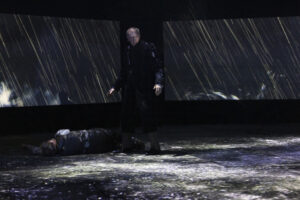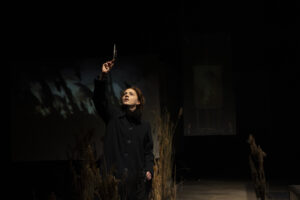Is this Sheridan Smith’s best ever performance on stage?
★★★★★

You know those newspaper features where people are asked who they would invite to dinner.? Sheridan Smith has gone right to the top of my list. She may only have been acting out Willy Russell’s excellent script, but her performance in Shirley Valentine shows what an exceptional actor she is. From the very start, she has the audience in the palm of her hand. She looks at them, she smiles at them, she draws them into her confidence. And she knows how to tell a story and deliver a punchline. It is probably her best ever performance on stage.
Shirley Valentine is one of a triumvirate of plays, along with Educating Rita and Blood Brothers that were written in the 1980s by Willy Russell and established him as one of the great playwrights of his generation. All feature Liverpudlians, they’re all funny, they all have a natural flowing dialogue, and they all show deep understanding of what it is to be human. Shirley Valentine is a woman trapped in a humdrum life, with grown up children and a loveless marriage to an unappreciative, domineering man.
We first meet her in her kitchen. There’s a challenge in producing an intimate play for one person in a small space but set designer Paul Wills has been very clever. He compensates for the height and depth of the Duke Of York’s stage by adding an upstairs layer to the three walls of the kitchen, which sketches a monochrome bedroom and bathroom level. The three walls make no pretence to be a contained room, in fact they clearly take advantage of the space by using the gaps to suggest a brighter world beyond.
There is no danger of this one woman show being static, director Matthew Dunster keeps Sheridan Smith moving about the stage. At one point, she actually cooks ‘chips and eggs’ while continuing to talk- great acting indeed, and so much better than a plate of fake food.
Astounding rapport with the audience
Shirley chats about her life, using the concept of her talking to the wall but actually removing the fourth wall altogether to address the audience directly. She uses a treasure chest of acting skills: she speaks as if she is sharing a confidence with friends- clearly but without ever seeming to raise her voice, she smiles sweetly at us, gives us a sly glance, pauses for us to fill in, in our minds, what she is about to say. Her rapport with her audience is something to behold- and indeed experience.
Shirley knows that she has reached middle age unfulfilled but she accepts her submissive role in life and sees no prospect of escaping it. It’s not that she is without insight or dreams or the thought of rebellion: ‘I have allowed myself to lead this little life,’ she says, ‘when inside me there was so much more.’
She tells many amusing anecdotes about her life at school, where her confidence was knocked out of her, as happens to so many working class kids. Even funnier are her subsequent encounters with her grown-up and apparently successful friends, which only underline the emptiness of her repetitive, servile life in which dinner must be on the table each evening as her husband walks through the door.
Then she is presented with the opportunity to go with a friend to Greece. At first, it’s more of a fantasy than something she would really do, but certain events tip her into deciding to do it.
After the interval, we spend a short but intense time with Shirley in Greece. The stage is now wide open with a blue Mediterranean sky as a backdrop. She tells us- and a rock- what has happened. Her impressions of a philandering bar owner, jingoistic English tourists, and her own liberated self make this a hilarious and satisfying final act.
Sheridan Smith took the curtain call like someone genuinely happy to have shared the evening with us, nodding and smiling and pointing. And, judging by the loud and long applause, the feeling was mutual.
Shirley Valentine is at the Duke Of York’s Theatre until 3 June 2023. There are hopes it may tour.
Paul purchased his ticket.

